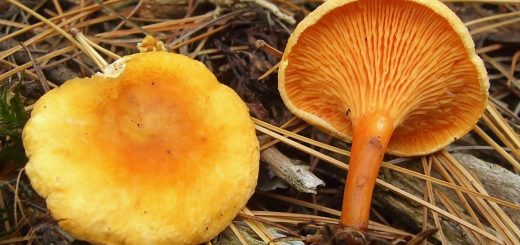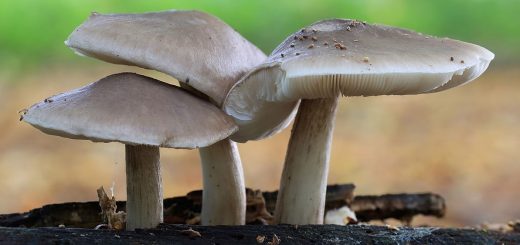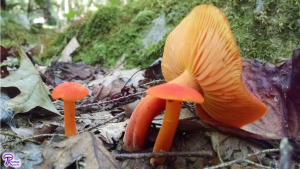#119: Pisolithus arrhizus, the Dyeball [Archived]
Note: This is an archived post. You can find the current version of this post here.
“Our next contestant in the Ugly Mushroom contest performs thousands of hours of community service every year and is an accomplished artist. Its goal in life is to make the world a better place and form lasting relationships with those around it. Give it up for…Pisolithus arrhizus! [applause]” There seems to be little doubt among people that arrhizus is one of the ugliest mushrooms in the world. The fruiting bodies of older specimens become distorted and can be mistaken for anything from animal poop to decomposing tree stumps. Despite its unsightly appearance, this earthball can be used to dye wool, thus earning it the common name, “Dyeball.” The fungus is also prized by gardeners and foresters for its ability to form robust mycorrhizae in extremely poor soil conditions.
Young Dyeballs look a lot like most other earthballs. They are roughly spherical with a smooth surface dominated by white, yellow, purple, or brown shades. The base of the mushroom forms a root-like structure that projects down into the ground. If you dig up the whole mushroom, you will often find yellowish threads attached to the base. These threads are bundles of fungal cells called “rhizomorphs” that attach the mushroom to the main body of the fungus, which is an underground network of cells. Unlike most earthballs, the outer skin of the Dyeball is quite thin and easily broken.
The most distinctive feature of this mushroom is its interior. When sliced in half (top to bottom), the Dyeball displays a beautiful mosaic pattern in its gleba (spore-producing interior). At the very bottom, the sterile, root-like base is brownish in color. Just above that, you can see tiny, whitish to yellowish dots called “peridioles” that stand out against the black, tar-like material surrounding them. As you move up the mushroom, the peridioles get larger and become roughly pea-sized. The space between the peridioles decreases as they get larger, so they become squished into an irregular, tessellating pattern. About halfway up the fruiting body (or higher/lower if the mushroom is younger/older), the peridioles start turning black or olive in color. Each peridiole is a bundle of spore-producing tissue, so it is at this point that spores are beginning to be produced. At the top of the mushroom, the mature spores in the peridioles become cinnamon-brown and powdery. At this point, the walls between the peridioles start to break down, leaving an undifferentiated mass of powdery, brown spores at the very top of the earthball.
Soon after mature spores are produced, the skin on the top of the mushroom cracks open to reveal the powdery mess. The Dyeball can still produce more spores once this happens because peridioles mature from the top down. At this stage, mushroom growth becomes somewhat erratic, causing the Dyeball to look less and less like a ball. Mature P. arrhizus mushrooms grow up to 20cm (about 8in) across and 5-30cm (2-12in) or more tall and often end up in strange shapes, such as that of a pile of dung, a tree stump, a top, or an enormous molar, among other bizarre shapes. This mushroom’s odor becomes fouler as it matures, but starts out as mild to fragrant.
P. arrhizus can be found all across the globe in at least 33 different countries. It is widespread in North America, though most commonly encountered in the southeastern and pacific coast regions. The mushrooms appear in the summer and fall, bot may also fruit in the winter in warmer climates.
One of the most significant things about this mushroom is its ability to form “super-mycorrhizae.” P. arrhizus is a mycorrhizal fungus, meaning it forms mutualistic relationships with trees. In this relationship, the fungus gives the tree nutrients like phosphorous and nitrogen in exchange for sugar. The Dyeball is exceptionally good at holding up its end of the bargain. For this reason, foresters and others often inoculate tree seedlings with P. arrhizus spores to give their early growth a boost. Another reason that P. arrhizus is commonly used to inoculate saplings is that it forms mycorrhizae with a wide variety of trees, including various species of pine, birch, oak, eucalyptus, Douglas-Fir, hemlock, willow, and poplar. The Dyeball is also useful in reclamation and reforestation efforts because it can grow in very poor soils with high: acidity, heavy metal concentration, temperatures, and likelihood of drought. In fact, this mushroom is most frequently found in sandy soil, gravel, runoff ditches, and lawns and has even been known to push through asphalt!
The Dyeball, as its common name implies, can also be used for dyeing wool. It seems counterintuitive, but most of the bright, pretty mushrooms are completely useless when it comes to dyeing. The dark, ugly mushrooms work much better and can give some surprising colors. P. arrhizus imparts wool with a reddish-brown or blackish color. These colors come from the tar-like gel between the peridioles, so younger Dyeballs work better.
P. arrhizus is placed in the phylum Basidiomycota, class Agaricomycetes, order Boletales, and family Sclerodermataceae. This classification shows it has some interesting relatives. Its closest relatives are other earthballs, which belong to the same family. All earthballs, including P. arrhizus, belong to the Boletales, which also includes the boletes (umbrella-shaped mushrooms with pores underneath the cap). This relationship may explain the unusual peridioles in P. arrhizus. Earthballs are thought to have evolved from boletes by not opening up fully. The advantage to this is that a fully closed exterior protects against water loss. If this is true, then the preidioles may be evolutionary remnants of bolete pores!
Finally, a couple notes on the names. P. arrhizus is also called P. arhizus or P. tinctorius. All three names are used by various websites and field guides, so don’t be surprised when you come across the other names. I used P. arrhizus in this post because that name seems to be the most up-to-date name. “Piso-” means “pea” and “lith” means stone, so the genus name, Pisolithus, means “pea-stone.” This alludes to the mushroom’s unique gleba. The name “arrhizus” means “having no roots” and does not describe any obvious part of the mushroom. I like the name “tinctorius” better because it refers to the earthball’s use in yarn dyeing. If you ask me, “wool-dyeing pea-stone” is a better description of the mushroom than “rootless pea-stone,” but I really don’t have any say in the matter. Wikipedia suggests that multiple species may be included in the current definition of “P. arrhizus.” If further studies demonstrate that this is the case, then it seems likely to me that most North American specimens will get the name “P. tinctorius,” while European specimens will retain “P. arrhizus.”
To add to the naming confusion, P. tinctorius has a number of different common names. In North America, the most common name is “Dyemaker’s Puffball.” Unfortunately, it is actually placed in the “False Puffball” or “Earthball” morphological group, so the correct names to use would be “Dyemaker’s False Puffball” and “Dyemakers Earthball.” These names haven’t quite caught on, but “Dyeball” is a popular alternative. That name is short and frequently used, which is why I chose to use it in this post. A number of other common names describe the earthball’s unsightly appearance, including: “Dead Man’s Foot,” “Dead Man’s Fist,” and many variations on “Dog Turd Fungus.” In Australia, this mushroom is apparently called the “Horse Dung Fungus.” Some places in Germany called this earthball the “Bohemian Truffle” and have historically eaten it. The mushroom may be poisonous, so I recommend against its consumption. Also, why would you want to? The Dyeball looks anything but appetizing.
See Further:
http://botit.botany.wisc.edu/toms_fungi/jun2003.html
http://www.mushroomexpert.com/pisolithus_tinctorius.html
http://www.mykoweb.com/CAF/species/Pisolithus_arhizus.html
http://www.first-nature.com/fungi/pisolithus-arrhizus.php
http://www.ncbi.nlm.nih.gov/pubmed/856419
https://en.wikipedia.org/wiki/Pisolithus_arrhizus
http://www.mushroomexpert.com/taxonomy.html
http://www.joshsfrogs.com/catalog/blog/2014/07/whats-name/ (for the etymology of “tinctorius.” Apparently there is a poisonous frog which shares that name.)









![#011: Characteristics of Kingdom Fungi [Archived]](https://www.fungusfactfriday.com/wp-content/themes/hueman/assets/front/img/thumb-small-empty.png)


1 Response
[…] see that the gleba is not a solid color but is riddled with white lines separating the locules. Pisolithus arrhizus, commonly known as the “dyemaker’s puffball,” offers a better view of its locules. When you […]